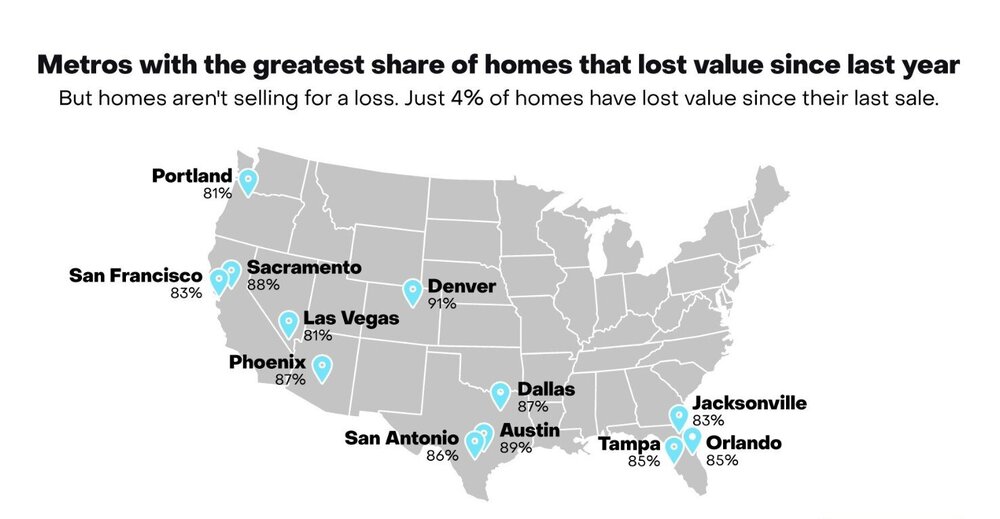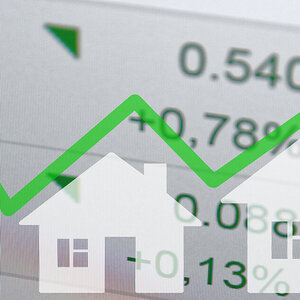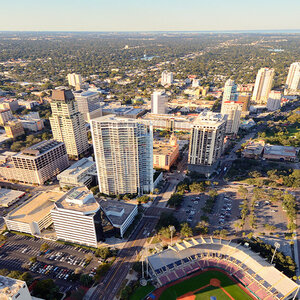Residential Real Estate News

U.S. Housing Market Hits a Turning Point, Over Half of Homes Lose Value in 2025
Residential News » Seattle Edition | By Michael Gerrity | November 20, 2025 8:22 AM ET
Biggest Share of Home Price Declines Since 2012
The American housing market is entering a new phase of cooling, with a majority of homeowners now seeing their property values slip from last year's highs. New analysis from Zillow shows that 53% of U.S. homes have lost value over the past 12 months -- the largest share since 2012, when the market was clawing its way out of the post-recession trough.
The shift represents a dramatic reversal from 2023, when only 14% of homes were declining in value. But economists say the pullback reflects normalization after years of overheated appreciation, not the start of a broad market downturn.
"Homeowners may feel rattled when they see their Zestimate drop," said Treh Manhertz, a senior economic researcher at Zillow. "But relatively few are selling at a loss. Home values surged over the past six years, and the vast majority of homeowners still have significant equity. What we're seeing now is a normalization, not a crash."
A Cooling Market With Deep Equity Cushions
Despite widespread one-year declines, the typical U.S. homeowner remains far ahead. Since the median last sale -- roughly eight and a half years ago -- home values have climbed 67%. In some supply-constrained markets, gains have been nearly double that pace. Buffalo leads major metros with a staggering 108% increase since last sale, followed by San Jose (97%), Providence (95%), Columbus (90%) and San Diego (88%). Owners in these areas often stay put longer, compounding equity growth.
Still, the current pattern of short-term declines is creating anxiety. For many households, a home is their largest asset, and its value is closely tied to long-term savings and retirement plans. Zillow's data suggests that most homes have slipped from their peak by an average of 9.7%, a modest pullback compared with the 27% drawdown seen at the bottom of the last housing crash in 2012 -- but higher than the unusually small 3.6% dip recorded in the spring of 2022 during the pandemic boom.
Losses at Sale Remain Uncommon
The metric that matters most -- whether a home is worth less than its previous sale price -- remains historically low. Only 4.1% of homes are currently valued below their last sale price, up from 2.4% a year ago but well below the 11.2% rate seen before the pandemic.
The tight inventory environment is playing a major role. While price growth has stalled, a chronic shortage of homes for sale is preventing widespread distress. Just 3.4% of new listings are priced below their last sale price -- a slight uptick from last year but still only about half the pre-pandemic 2019 level of 5.9%.
Regional Divergence Widens
The markets seeing the biggest share of sellers cutting prices tend to be those that overheated most in the pandemic's early years -- as well as the nation's costliest metros.
San Francisco tops the list, with 14% of new listings priced below their last sale, followed by Austin (13%), San Jose (9%), San Antonio (8%) and Dallas (7%). By contrast, markets such as Providence, Milwaukee and Cincinnati are barely seeing any losses at all, with fewer than 1% of new listings priced below their prior purchase price. Thirteen more metros across the Northeast, Great Lakes, South and Midwest are below 2%.
A Market Edging Back Toward Balance
Nationwide home value appreciation has effectively flattened over the past year, but the aggregate masks sharp regional divides. Local market performance now varies not just by metro but by neighborhood -- even block by block. With mortgage rates elevated and affordability stretched thin, economists expect unevenness to persist through 2025.
For now, the story of U.S. housing is less about collapse and more about comedown. After years of breakneck gains, the market is recalibrating -- and while more than half of homeowners may be staring at lower Zestimate values, only a small minority are confronting actual losses.
The correction, in other words, is real -- but so is the cushion.
Sign Up Free | The WPJ Weekly Newsletter
Relevant real estate news.
Actionable market intelligence.
Right to your inbox every week.
Real Estate Listings Showcase
Related News Stories
Residential Real Estate Headlines
- Las Vegas Market Cools as Home Prices, Sales Dip in October
- U.S. Opportunity Zone Home Prices Keep Pace with Broader Market
- First-Time Homebuyers in U.S. Hit Record Low as Affordability Crisis Deepens
- U.S. Home Prices Go Flat in September as Inventory Climbs to Six-Year High
- Alpine Luxury Homes Soar as Europe Defies Global Slowdown
- The World's MLS Announced, Designed to Slash Seller Costs on a Planetary Scale
- Luxury Home Segment Defies U.S. Market Slowdown
- Pending Home Sales in U.S. Remain Flat in September
- Greater Palm Beach Area Residential Sales Posts Strong Gains in September
- U.S. Home Sales Uptick in September as Mortgage Rates Fall
- U.S. Single-Family Rent Growth Hits 15-Year Low
- U.S. Home Buyers Hold the Cards in Late 2025
- U.S. Renters Get First Price Break in Four Years this Fall
- Orlando Housing Market Gives Mixed Signals in September
- U.S. Foreclosure Filings Jump 17 Percent Annually in Q3 Signaling Borrower Strain
- Greater Las Vegas Housing Market Sees Price Cooling in September as Inventory Climbs
- Global Super-Prime Home Sales Surge in Mid-2025
- Greater Fort Lauderdale Area Residential Sales Drop 12 Percent in August
- UBS Flags Miami, Tokyo, Zurich as World's Top Housing Bubble Risk Markets in 2025
- Government Shutdown Threatens to Snarl the U.S. Housing Market, Cloud Fed Policy
- Home Price Growth Stalls as U.S. Housing Market Shows First Signs of Cooling in 2025
- Pending Home Sales Rise in August as Lower Rates Spur U.S. Buyers
- U.S. Homebuyer Affordability Improves for Fourth Straight Month
- U.S. New-Home Sales Surge in August as Mortgage Rates Ease
- Despite Increased Foreign Buyer Activity, Miami Residential Sales Dip 11 Percent in August
- California Home Sales Enjoy Modest Uptick as Mortgage Rates Ease
- U.S. Home-Flipping Profits Sink to Lowest Level Since 2008 Financial Crisis as Costs Climb
- Why the World's Rich Are Flocking to Europe in 2025
- Federal Reserve Delivers First Rate Cut of 2025 as Mortgage Relief Proves Limited
- Homebuilder Sentiment Holds Steady in U.S. as Rate-Cut Bets Lift Outlook
- U.S. Mortgage Rates Experience Sharpest Weekly Drop in Over a Year
- U.S. Foreclosures Rise for Sixth Straight Month as Affordability Pressures Mount
- Black U.S. Homeownership Rate Falls to Two-Year Low as Job Losses Mount
- Las Vegas Home Prices Flatten as Listings Surge, Sales Slow
- Cooling Miami Housing Market Sees 16 Percent Annual Sales Drop in July
- U.S. Mortgage Delinquencies Uptick in June Amid Regional Pressures
- California, Florida Top U.S. Housing Markets Most at Risk of Downturn
- 30-Year Mortgage Drops to 6.56 Percent in Late August, Lowest Since October 2024
- Investors Maintain Elevated Role in U.S. Housing Market Despite Slight Pullback
- Pending Home Sales Show Mixed Signals as U.S. Buyers Remain Cautious








